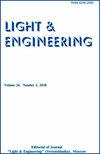The Interrelation between Temperature and Power Supply Modes of Low Power High Efficiency Light Emitting Diodes
IF 0.3
4区 工程技术
Q4 ENGINEERING, ELECTRICAL & ELECTRONIC
引用次数: 0
Abstract
The studies of interrelation between temperature and power supply modes of low power high efficiency light emitting diodes and the effect of temperature on their direct voltage were analysed. It is discovered that there are significant differences in the experimental data on temperature modes obtained by many authors. A new dynamic method of measurement of overheating temperature in the active region of p-n structures at pre-set direct current is applied. This method is based on registration of the transient processes of direct voltage changes during heating by pre-set current and cooling-down after switching-off of the heating current at constant low direct current. The formula is obtained for calculation of the proportion factor of direct-voltage temperature dependence for diodes with different techno structures accounting for the measurement current, the non-ideality factor of the voltage-current curve, and temperature. The experimental curves of the LED active region temperature dependence on heating current at its density of (10–110) A/cm2 and dissipated power of (0.025–0.45) W are obtained. The direct-voltage temperature dependence proportion factor was modelled at different values of measurement current for specific LEDs. It is demonstrated that the active region of LEDs based on wide-band-gap semiconductors overheats due to formation of hot charge carriers interacting with optic phonons in it at current densities, when the exponential nature of the voltage-current curve is disturbed.低功率高效发光二极管的温度与供电方式的关系
分析了温度与低功率高效发光二极管供电方式的相互关系以及温度对其直流电压的影响。我们发现,许多作者所得到的温度模态实验数据有很大的差异。提出了一种新的动态测量p-n结构在直流电预置下有源区过热温度的方法。该方法基于在恒定的低直流下,通过预先设定电流和切断加热电流后的冷却来记录加热过程中直流电压变化的瞬态过程。得到了不同工艺结构二极管在测量电流、电压-电流曲线非理想性因子和温度的影响下,直接电压温度依赖比例因子的计算公式。得到了LED在密度为(10-110)A/cm2、耗散功率为(0.025-0.45)W时,主动式温度随加热电流变化的实验曲线。对特定led在不同测量电流值下的直接电压温度依赖比例因子进行了建模。研究表明,当电压-电流曲线的指数特性受到干扰时,基于宽带隙半导体的led的有源区由于在电流密度下形成热电荷载流子与其中的光学声子相互作用而过热。
本文章由计算机程序翻译,如有差异,请以英文原文为准。
求助全文
约1分钟内获得全文
求助全文
来源期刊

Light & Engineering
ENGINEERING, ELECTRICAL & ELECTRONIC-OPTICS
CiteScore
1.00
自引率
50.00%
发文量
0
审稿时长
1 months
期刊介绍:
Our magazine
develops comprehensive communication within the lighting community, providing opportunities for discussion and free expression of opinions of specialists of different profiles;
contributes to the convergence of science and engineering practice, the search for opportunities for the application of research results in lighting and technological applications of light;
keeps the scientific community up to date with the latest advances in the theory of the light field, providing readers with operational professional information;
initiates international cooperation, promotes and distributes the results of Russian authors in the international professional community;
provides equal opportunities for authors from different regions of Russia and other countries.
The journal publishes articles in the following areas:
visual and non-visual effects of radiation on humans;
light field theory;
photometry and colorimetry;
sources of light;
ballasts;
light devices, their design and production technology;
lighting and irradiation installation;
light signaling;
methods of mathematical modeling of light devices and installations;
problems of energy saving in lighting, installation and operation of lighting installations;
modern production technologies of lighting products for lighting control systems;
innovative design solutions;
innovations in lighting and lighting design;
the study of the effect on plants and animals, problems of using light in medicine;
problems of disinfection of premises, water and smell elimination with the help of technology of UV radiation using;
problems of light in the ocean and space.
 求助内容:
求助内容: 应助结果提醒方式:
应助结果提醒方式:


